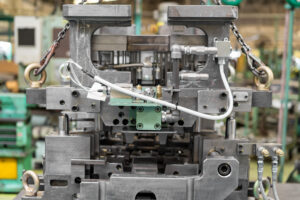Intro
We’ve created countless die-cast parts for our clients over the years. A lot of people come to us because their previous die-casting partner returned defective parts. To clear things up, our experts put together this quick guide of 6 common casting defects.
We’ll explain what they are, why they happen, and how to fix the problem. Spoiler alert: a lot of issues can be avoided by sticking with a high-quality casting partner.
Runout
Runout is a low spot in your part. Typically, it’s an area that has no metal at all, surrounded by an area with thinner metal.
This is the result of a lack of uniform molten metal across the mold. Typically, it means that metal is escaping somewhere from the mold as a result of a bad mold design or faulty die-casting machine.
The solution: Make sure you stick with a high-quality mold-making shop like Rapid Axis. Going for a “cheap” company might save you money, but you’ll run into issues like runout after some time.

Swells
A swell looks like a bulge on your part. It’s commonly on the outside faces that touch the mold, and it’s due to a low-strength mold. It can also be an indicator that your mold is nearing its shelf life and you’ll need to replace it before making more units.
The solution: The only solution is to replace the mold. If you are experiencing premature swelling, then opt for a higher-strength steel on your next mold design or swap to a different mold manufacturer.
Mismatched Parts
If the two halves of your part aren’t perfectly aligned, you can blame the mold or core of the casting machine. This happens when one half of your die shifts during the process, giving you a lopsided or mismatched part.
It could be due to loose box pins, incorrect dowel pins, or user error when it comes to placing both halves of the mold.
The solution: The first step is to troubleshoot the die-casting machine. If pins are broken or missing, it will be easy to spot and replace. If it’s due to user error, you might want to pick a more experienced die-casting shop.
Porosity Defects
This form of die-casting defect looks like holes scattered across your part. They could be small pinholes, or much larger “open holes”. They are commonly found around circular features of your part, and they might need an X-ray just to spot them.
Almost all of these porosity defects are due to gases getting trapped and released during the die-casting operation. The metal alloy itself could have gas inside, the mold release agent might cause these holes, or moisture could evaporate and cause pores.
The solution: A good starting point is to ensure the metal ingots are always clean and dry before use. In addition, the die-caster might need to tweak their speed and pressure to avoid this off-gassing. Finally, consider opting for a higher-quality alloy or mold release agent to prevent porosity defects.
Shrinking or Warpage
If your flat part has low spots or an uneven angle to its sides, you might be dealing with warping or shrinkage. You might also notice jagged cracks along the walls of your part, which is another example of shrinkage.
The root cause for this issue is an uneven gradient of temperature across your part during the heating and cooling steps. This might be from uneven airflow or incorrect pouring within the mold. Another common cause is a mold cavity with uneven thickness or a poor design.
The solution: Redesigning the mold cavity is one way to fix this problem, and it helps if you run a simulation to see how the metal will move across the mold during die-casting. For a simpler solution, try cleaning the cavity and increasing the metal injection pressure.
Soldering
Soldering is one of the more common defects that you might spot on your cast part. It looks like a line, typically along the inside faces of your part.
It can be seen by eye, and it’s the result of overheated metal fusing itself to the wall of your part after pouring. If it’s not due to roughness in your die cavity, you can blame overheating of the metal, poor quality of the mold release agent, or low iron levels in the alloy you’re using.
The solution: Start by smoothing out the cavity if there’s a rough spot in the same area where you’re noticing soldering. Next, opt for a higher-quality material and mold agent to avoid this issue. For reference, you should have between 0.8% and 1.1% iron in your alloy.
Conclusion
We just covered 6 common casting defects that you might see in your die-cast parts. As you saw, a lot of these defects are due to user error, poor mold fabrication, or die-casters cutting corners on their materials. Avoid these issues by using our professional die-casters at Rapid Axis. We are a full-service shop that offers casting and a full suite of finishing steps to get you the best results. Get a free quote today.
